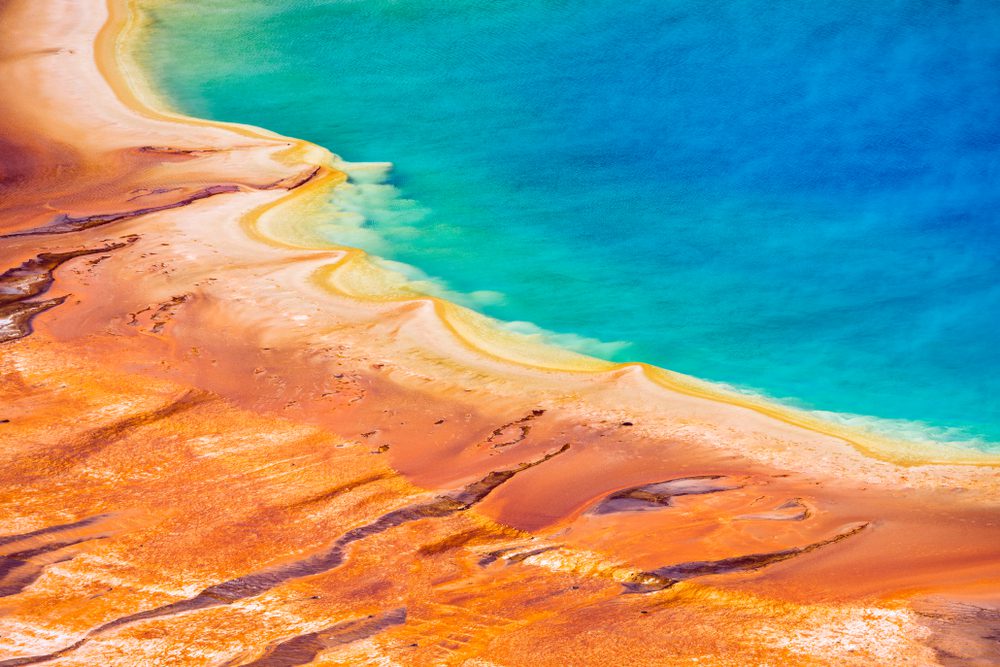The Grand Prismatic Spring of Yellowstone National Park is the largest thermal spring in the US and the thirds largest in the world. But the sheer size of this 61-100 meter (200-330 feet) wide, almost 50 meters (160 feet) deep body of water isn’t what makes it Yellowstone’s most photographed feature.
First named in 1871, the Grand Prismatic Spring gets its name from the distinct and brightly colored rings that surround it. The difference in water color for each ring is dependent on differences in water temperature. This also means that seasons affect the color of the spring’s waters, with deeper colors appearing in the summer months.
While geysers shoot hot water through obstructions in the Earth’s surface, thermal springs are formed when there is no obstruction, allowing hot water to flow constantly out of cracks in the ground.
This super-heated water pools in the middle of the spring, where it sits at a balmy 87°C (189°F). As it spreads further from the spring’s center, the temperature drops, creating a gradient of water temperatures traveling away from the spring’s source.
But how does this explain the color? The spring’s bright rings actually come from the different types of thermophilic bacteria that are able to survive at the water’s varying temperatures.

Image credit: Filip Fuxa / Shutterstock
Blue
The spring’s bubbling deep blue center is the hottest part of the feature. These near-boiling temperatures aren’t fit to sustain most bacterial life. The only bacteria able to survive in these conditions feed on hydrogen gas and other inorganic chemicals rather than organic matter.
For this reason, the deep blue shade of the spring’s center is caused by the same thing that makes the ocean blue, the scattering of blue wavelengths.
This incredibly clear and deep-blue colored water has little interference from murky contaminants, so as light waves pass through it, red wavelengths are absorbed quickly while blue wavelengths travel to the depths of the spring. Water molecules scatter blue wavelengths and reflect them back to the eye, making the water appear a consistent blue shade.
Yellow
Surrounding the blue center is a ring of yellow. The water in this area sits at around 74°C (165°F), which is still largely uninhabitable with the exception of one type of cyanobacteria called Synechococcus.
The Synechococcus group of unicellular cyanobacteria are fairly widespread in marine environments where their photosynthetic pigments make them appear in a variety of different colors.
Their color is produced by photosynthetic pigments: In the spring’s waters, Synechococcus has lower levels of chlorophyll pigment, which usually appear green, and higher levels of carotenoid pigments, which appear orange or yellow.
The use of carotenoid pigment protects the Synechococcus from the direct and constant sunlight on the spring. Carotenoids are able to absorb harmful ultraviolet rays and continue the photosynthesis process.
Orange
As the water cools further in the next layer, more bacteria are able to survive and join Synechococcus in a colorful soup of bacteria. The water temperatures at this stage are around 65°C (149°F), which is cool enough to support Chlorobacteria.
Chlorobacteria, or Chloroflexi bacteria, are a diverse phylum that thrive in high temperatures and produce energy through photosynthesis.
While all the bacteria at this level still get their color through photosynthesis, specifically through the carotenoid pigment, they all produce slightly different shades of red through to yellow. This is what causes the murkier appearance of the orange ring, as it’s a combination of a number of different shades of bacteria.
Red
The final ring on the Grand Prismatic Spring sits at a more comfortable 55°C (131°F). At this temperature, a larger variety of bacteria are able to survive and thrive, adding to the murkiness of the previous layer to create a reddish-brown color.
With as many as 4 million visitors flocking to see the Grand Prismatic Spring in some years, unsurprisingly the National Park Services urges visitors to view with caution due to the water’s severe temperatures.
Source Link: Why Is Yellowstone’s Grand Prismatic Spring Rainbow-Colored?